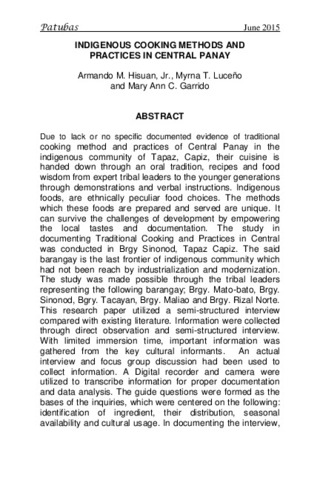Indigenous cooking methods and practices in Central Panay
| dc.contributor.author | Hisuan Jr., Armando | |
| dc.contributor.author | Luceño, Myrna T. | |
| dc.contributor.author | Garrido, Mary Ann C. | |
| dc.coverage.spatial | Tapaz | en_US |
| dc.coverage.spatial | Central Panay | en_US |
| dc.date.accessioned | 2021-08-06T04:24:49Z | |
| dc.date.available | 2021-08-06T04:24:49Z | |
| dc.date.issued | 2015-06 | |
| dc.identifier.citation | Armando, A. M. , Luceño, M. T. & Garrido, M. A. C. (2015). Indigenous cooking methods and practices in Central Panay Patubas, 10(1), 91-120. | en_US |
| dc.identifier.issn | 1908-515X | |
| dc.identifier.uri | https://hdl.handle.net/20.500.12852/1298 | |
| dc.description | Journal article | en_US |
| dc.description.abstract | Due to lack or no specific documented evidence of traditional cooking method and practices of Central Panay in the indigenous community of Tapaz, Capiz, their cuisine is handed down through an oral tradition, recipes and food wisdom from expert tribal leaders to the younger generations through demonstrations and verbal instructions. Indigenous foods, are ethnically peculiar food choices. The methods which these foods are prepared and served are unique. It can survive the challenges of development by empowering the local tastes and documentation. The study in documenting Traditional Cooking and Practices in Central was conducted in Brgy. Sinonod, Tapaz Capiz. The said barangay is the last frontier of indigenous community which had not been reach by industrialization and modernization. The study was made possible through the tribal leaders representing the following barangay; Brgy. Mato-bato, Brgy. Sinonod, Bgry. Tacayan, Brgy. Maliao and Brgy. Rizal Norte. This research paper utilized a semi-structured interview compared with existing literature. Information were collected through direct observation and semi-structured interview. With limited immersion time, important information was gathered from the key cultural informants. An actual interview and focus group discussion had been used to collect information. A Digital recorder and camera were utilized to transcribe information for proper documentation and data analysis. The guide questions were formed as the bases of the inquiries, which were centered on the following: identification of ingredient, their distribution, seasonal availability and cultural usage. In documenting the interview, the interviewee has been given the option to decline the interview process. The time spent had been around four days to establish rapport and interaction with indigenous people specially those belonging to the older generations and acquire knowledge in indigenous cooking methods. The respondents had been given a chance to review the finding of the study for consistency and validity in the recently concluded IP Week Celebrations 2017. Thematic Analysis had been used in analyzing the data collected. Information gathered had been categorized according to emerging themes in occasion, rituals, preparation and presentation. The Indigenous cooking will becomes richer and it can provide livelihood and financial opportunity to the community. The Indigenous Cooking Methods of Central Panay revolves on Binakol and Tinum-anan, it depicts a simple way of preparing, cooking and presenting their food that would compliment their daily life activities and cultural identity. Thus, pursuant to Republic Act 8371 chapter VI with regards to the Protection of Indigenous Culture, Traditions and Institutions, this research on Indigenous cooking of Central Panay, Tapaz, Capiz had been conducted. | en_US |
| dc.language.iso | en | en_US |
| dc.publisher | Central Philippine University | en_US |
| dc.subject.lcsh | Cooking | en_US |
| dc.subject.lcsh | Indigenous peoples | en_US |
| dc.subject.lcsh | Indigenous peoples--Food | en_US |
| dc.subject.lcsh | Philippines--Capiz--Tapaz | en_US |
| dc.title | Indigenous cooking methods and practices in Central Panay | en_US |
| dc.type | Article | en_US |
| dc.citation.firstpage | 91 | en_US |
| dc.citation.lastpage | 120 | en_US |
| dc.citation.journaltitle | Patubas | en_US |
| dc.citation.volume | 10 | en_US |
| dc.citation.issue | 1 | en_US |
| local.subject | Panay Bukidnon | en_US |
이 항목의 파일
This item appears in the following Collection(s)
-
Patubas [110]
Patubas is a refereed research journal of Central Philippine University.


